John Hurrell – 6 April, 2023
This show is in essence about the research possibilities of drawing, but using installation, sculpture, prints, abstract and figurative drawing, painting and weaving to showcase now classic techniques such as positive / negative interaction—as well as stacking, scattering, skeletal linearising, leaning, suspending, perforating and so on—that exploit various transitive verbs.
Christchurch
Peter Robinson, Pauline Rhodes, Neil Dawson, Nikau Hindin, Barry Cleavin, Oliver Perkins, Bernard Cohen, Katie Thomas, Julia Morison, John Pule; Ella Sutherland, John Bevan Ford, Doreen Fraser, Bill Sutton, Gordon Walters, Charlotte Watson, David Cheer, Eleanor Hughes; Petrus van der Velden, Yvonne Sloan, Alice Julius; Thomas Gainsborough; Areta Wilkinson, Shannon Williamson; Ralph Hotere; Melissa Macleod
Die Cuts and Derivations
Curated by Ken Hall, Melanie Oliver, Felicity Milburn and Peter Vangioni
11 March 2023 - 2 July 2023
Sparked off by Peter Robinson’s interest in positive and negative die cut forms, and other organisational motifs—as seen in his included sprawling felt installation of the same title borrowed from a collector—this show pulls in artists from the gallery collection as foils, some even presenting on the walls traditional representational drawing with perspective, alongside two other substantial installations.
This show is in essence about the research possibilities of drawing, but using installation, sculpture, prints, abstract and figurative drawing, painting and weaving to showcase now classic techniques such as positive / negative interaction—as well as stacking, scattering, skeletal linearising, leaning, suspending, perforating and so on—that exploit various transitive verbs.
The two other (‘non-Die Cut‘) installations, by Neil Dawson and Pauline Rhodes, with Robinson form three distinctive groups to which the wall contributors can be divided up.
One of the pleasures of such sorting is looking for sympathetic drawing methods, vector tensions and morphic similarities, finding formal, associative or processual qualities that relate to particular installations. However, they are not discrete competing teams, and some artworks fit into more than one.
Here are some examples: Peter Robinson (Areta Wilkinson, Bernard Cohen, Oliver Perkins, Julia Morison, Melissa Macleod, John Pule, Katie Thomas); Neil Dawson (Carl Sydow; Shannon Williamson; Yvonne Sloan; Ella Sutherland; Charlotte Watson; Doreen Fraser); Pauline Rhodes (Gordon Walters; Alice Julius; Oliver Perkins, Eleanor Hughes; Bill Sutton; Petrus van der Velden; Katie Thomas, Thomas Gainsborough).
Within these groups I have noticed in the Rhodes’ presentation similarities between the dried tororaro on the wall and the tree drawings around the corner by Hughes, Julius and others. Or intriguing parallels between Sydow and Dawson. Or Cohen, Wilkinson and Robinson.
Fascinating though the above are when examining cross-contextual formal links, the show does have too much work and too many artists. It is cluttered, and would be improved with at least a quarter removed. Perhaps the traditional figurative pencil drawings could have been ignored. Certainly some artists have two works when only one would have sufficed. Maybe too many inhouse curators were involved.
Having said that, it is great fun as an exhibition to sift through. The three contrasting installations still look gloriously fresh today. Dawson’s Seascape (1979), showing tiny boats suspended in mid-air on tilted circular mesh seas, has a lot in common with the blue boat and sail shapes found in Rhodes’ Blue Mind Sampler (2020), while Robinson’s Die Cuts and Derivations (2015) and Rhodes, allude to detritus washed up on a sandy beach. Robinson’s use of colour seems to wittily reference early Tony Cragg.
This show is a nice way of thinking about the boundaries of drawing as an explorative activity, and what it might be in terms of unconventional approaches—far beyond linear pencil figurative techniques—such as incorporating found objects and exploiting negative-shape, frottage or flung fragments. It shows there are very many ways of making ‘readable marks’ in two or three-dimensional space.
John Hurrell

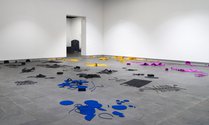
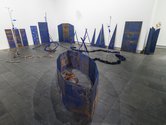
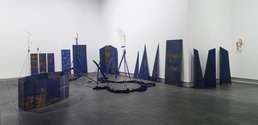
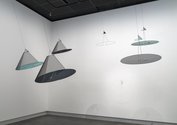
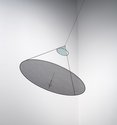
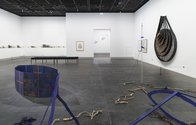
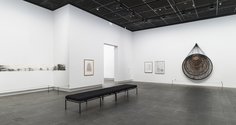
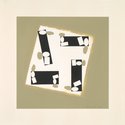
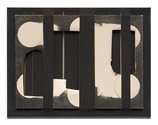
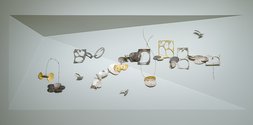
![Charlotte Watson, Disquiet, 2016. Charcoal and pencil on paper, [300gsm, watercolour] Purchased 2016 with funds generously donated by Sarah Lucas, Sadie Coles HQ, London and Two Rooms, Auckland, in response to the February 2011 Canterbury earthquake.](/media/thumbs/uploads/2023_04/12_Charlotte_Watson_jpg_380x125_q85.jpg)
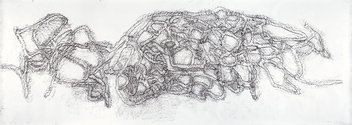

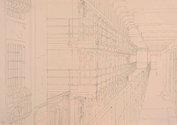
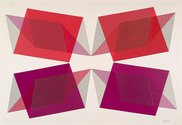
 Advertising in this column
Advertising in this column Two Rooms presents a program of residencies and projects
Two Rooms presents a program of residencies and projects



This Discussion has 0 comments.
Comment
Participate
Register to Participate.
Sign in
Sign in to an existing account.